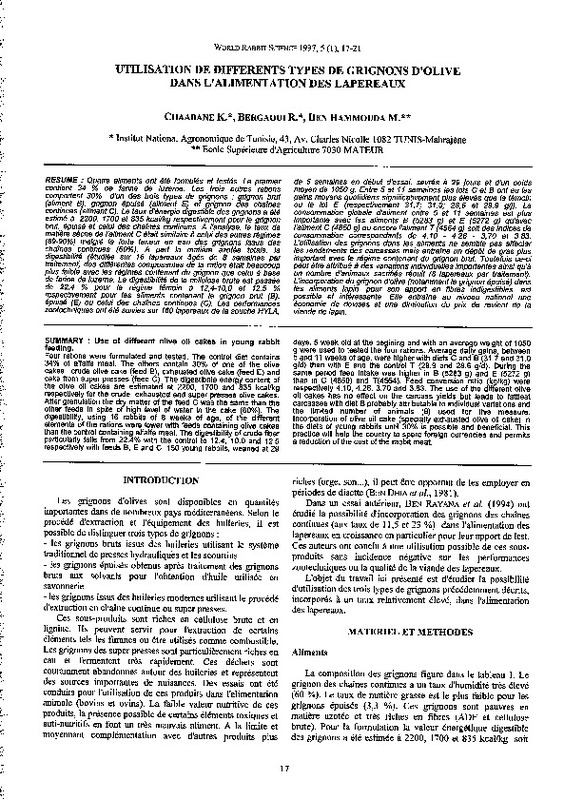JavaScript is disabled for your browser. Some features of this site may not work without it.
Buscar en RiuNet
Listar
Mi cuenta
Estadísticas
Ayuda RiuNet
Admin. UPV
UTILISATION DE DIFFERENTS TYPES DE GRIGNONS D'OLIVE DANS L'ALIMENTATION DES LAPEREAUX
Mostrar el registro sencillo del ítem
Ficheros en el ítem
| dc.contributor.author | Chaabane, K.
|
|
| dc.contributor.author | Bergaoui, R.
|
|
| dc.contributor.author | Ben Hammouda, M.
|
|
| dc.date.accessioned | 2011-03-21T09:56:21Z | |
| dc.date.available | 2011-03-21T09:56:21Z | |
| dc.date.issued | 1997 | |
| dc.identifier.issn | 1257-5011 | |
| dc.identifier.uri | http://hdl.handle.net/10251/10445 | |
| dc.description.abstract | [EN] Four rations were formulated and tested. The control diet contains 34% of alfalfa mea!. The others contain 30% of one of the olive cakes : crude olive cake (feed B), exhausted olive cake (feed E) and cake from super presses (feed C). The digestibnle energy content of the olive oil cakes are estimated at 2200, 1700 and 835 kcal/kg respectively for the crude, exhausted and super presses olive cakes. After granulation the dry matter of the feed C was the same than the other feeds in spite of high leve! of water in the cake (60%). The digestibility, using 16 rabbits of 8 weeks of age, of the different elements of the rations were lower with feeds containing olive cakes than the control containing alfalfa meal. The digestibility of crude fiber particularly falls from 22.4% with the control to 12.4, 10.0 and 12.5 respectively with feeds B, E and C. 160 young rabbits, weaned at 29 days, 5 week old at the begining and with an average weight of 1050 g were used to tested the four rations. Average daily gains, between 5 and 11 weeks of age, were higher with diets C and B (31.7 and 31.0 g/d) than with E and the control T (29.9 and 28.6 g/d). During the same period feed intake was higher in B (5283 g) and E (5272 g) than in C (4850) and T(4564). Feed conversion ratio (kg/kg) were respectively 4.10, 4.26, 3.70 and 3.83. The use of the different olive oil cakes has no effect on the carcass yields but leads to fattiest carcasses with diet B probably attributable to individual variations and the limited number of animals (8) used for this measure. lncorporation of olive oil cake (specially exhausted olive oil cake) in the diets of young rabbits until 30% is possible and beneficia!. This practice will help the country to spare foreign currencies and permits a reduction of the cost of the rabbit meat. | es_ES |
| dc.description.abstract | [FR] Quatre aliments ont été fonnulés et testés. Le premier contient 34 % de farine de luzeme. Les trois autres rations comportent 30"Jcí d'un des trois types de grignons : grignon brut (aliment B), grignon épuisé (aliment E) et grignon des cha1nes continues (aliment C). Le taux d'énergie digestible des grignons a été estimé a 2200, 1700 et 835 kcaVkg respectivement pour le grignon brut, épuisé et celui des cha1nes continues. A l'analyse, /e taux de matiére séche de /'a/iment C était similaire a celui des autres régimes (89-90%) malgré la forte teneur en eau des grignons issus des cha1nes continues (60%). A part la matiére azotée tata/e, la digestibi/ité (étudiée sur 16 lapereaux §gés de 8 semaines par traitement) des différentes composantes de la ration était beaucoup plus faib/e avec /es régimes contenant du grignon que celui a base de farine de /uzeme. La digestibilité de la cellulose brute est passée de 22,4 % pour le régime témoin 8 12,4-10,0 et 12,5 % respectivement pour les aliments contenant /e grignon brut (8), épuisé (E) ou ce/ui des cha1nes continues (C). Les perfonnances zootechniques ont été suivies sur 160 lapereaux de la souche HYLA, de 5 semaines en début d'essai, sevrés 8 29 jours et d'un poids mayen de 1050 g. Entre 5 et 11 semaines les lots C et B ont eu les gains moyens quotidiens significativement plus é/evés que le témoin ou /e lot E (respectivement 31,7; 31,0; 28,6 et 29,9 g/j). La consommation globale d'a/iment entre 5 et 11 semaines est plus importante avec /es aliments B (5283 g) et E (5272 g) qu'avec /'aliment C (4850 g) ou encare l'aliment T (4564 g) soit des indices de consommation correspondants de 4, 10 - 4,26 - 3,70 et 3,83. L 'utilisation des grignons dans les a/iments ne semb/e pas affecter /es rendements des carcasses mais entra1ne un dépót de gras plus important avec le régime contenant du grignon brut. Toutefois ce-ci peut étre attribué 8 des variations individue/les importantes ainsi qu'a un nombre d'animaux sacrifiés réduit (8 lapereaux par traitement). L'incorporation du grignon d'olive (notamment le grignon épuisé) dans les aliments /apin, pour son apport en fibres indigestibles, est possib/e et intéressante. Elle entra/ne au niveau national une économie de devises et une diminution du prix de revient de la viande de tapín. | |
| dc.language | Francés | es_ES |
| dc.publisher | World Rabbit Science. ICTA. UPV | es_ES |
| dc.relation.ispartof | World Rabbit Science | |
| dc.rights | Reserva de todos los derechos | es_ES |
| dc.title | UTILISATION DE DIFFERENTS TYPES DE GRIGNONS D'OLIVE DANS L'ALIMENTATION DES LAPEREAUX | es_ES |
| dc.type | Artículo | es_ES |
| dc.date.updated | 2011-03-21T09:45:43Z | |
| dc.identifier.doi | 10.4995/wrs.1997.313 | es_ES |
| dc.rights.accessRights | Abierto | es_ES |
| dc.description.bibliographicCitation | Chaabane, K.; Bergaoui, R.; Ben Hammouda, M. (1997). UTILISATION DE DIFFERENTS TYPES DE GRIGNONS D'OLIVE DANS L'ALIMENTATION DES LAPEREAUX. World Rabbit Science. 05(1). https://doi.org/10.4995/wrs.1997.313 | es_ES |
| dc.description.accrualMethod | SWORD | es_ES |
| dc.relation.publisherversion | https://doi.org/10.4995/wrs.1997.313 | es_ES |
| dc.description.volume | 05 | |
| dc.description.issue | 1 | |
| dc.identifier.eissn | 1989-8886 | es_ES |








